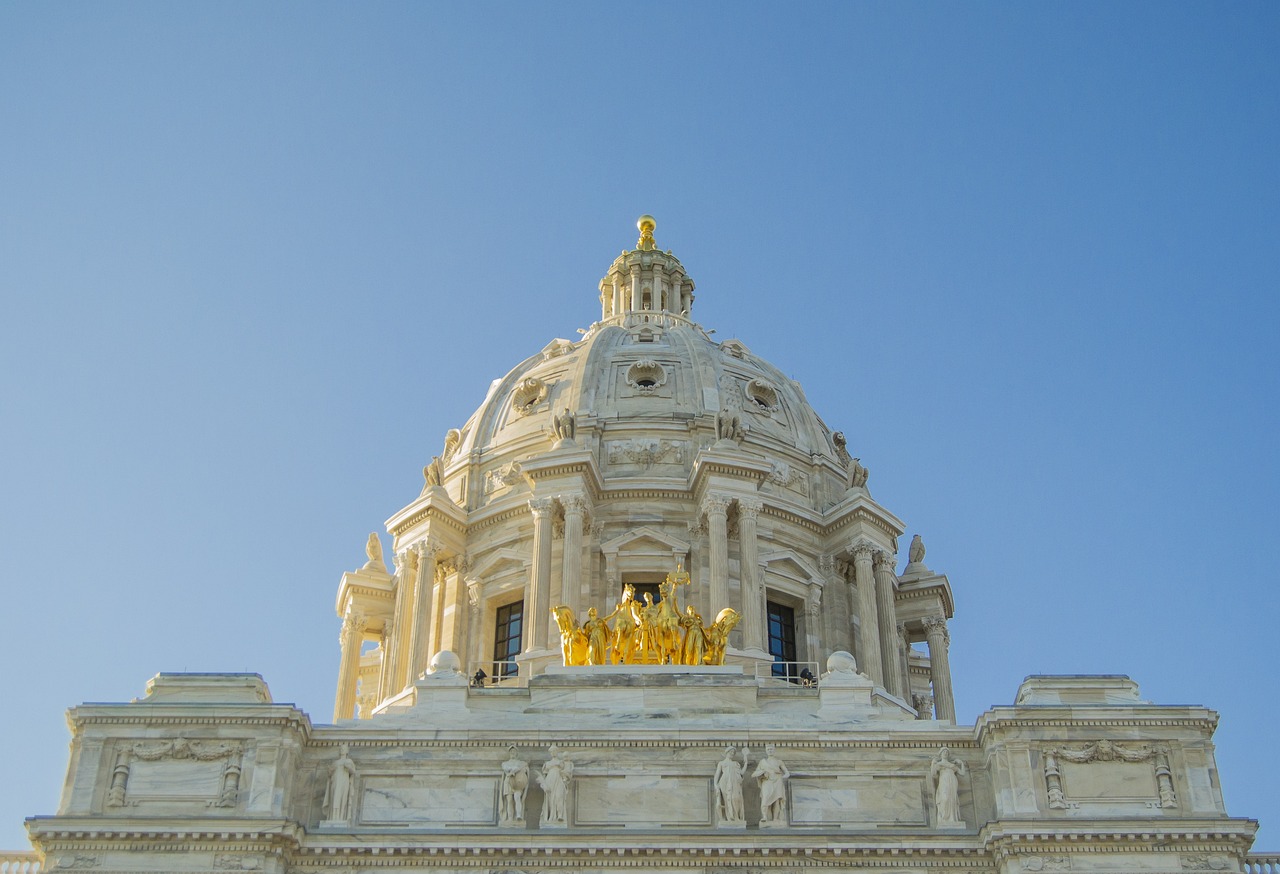Minnesota laws are created through a process called the legislative process. It begins when a bill is introduced by a member of the Minnesota House of Representatives or Senate. Once the bill is assigned to a committee, it is reviewed and discussed. If approved by the committee, the bill is sent to the full House or Senate for a vote. If both the House and Senate pass the bill, it is sent to the sitting Governor for signature. After the Governor signs the bill, it then becomes law. The process in Minnesota is similar to the legislative process much like other states in the United States.
Minnesota’s lawmaking process is a highly complex and dynamic process that involves multiple stages of review, debate, and compromise. It is heavily influenced by interest groups, lobbyists, and the state’s judicial system, as well as by the participation of citizens through the citizen initiative process.
For example: once a bill is introduced, it goes through several stages of review and debate before it can become law. The bill is first assigned to a committee, which is made up of a group of legislators who have expertise in the subject matter of the bill. The committee holds hearings and debates on the bill and may take many changes or recommendations before it is sent for a vote to the full House or Senate.
Providing the bill passes in the House or Senate, it it will go to the other chamber for consideration. If both the House and Senate pass the bill, it is then sent to a conference committee made up of members from both chambers. This committee is responsible for resolving any differences between the House and Senate versions of the bill.
Once the conference committee has agreed on a final version of the bill, it is sent to the full House and Senate for a final vote. If the bill passes in both chambers, it is sent to the Governor for signature. If the Governor signs the bill, it becomes law. If the Governor vetoes the bill, it can still become law if two-thirds of the members of the House and Senate vote to override the veto.
Worth noting that the Governor also has the power to call a special session of the legislature, which allows them to bring legislators back to the capitol to consider specific pieces of legislation.
The process of lawmaking in Minnesota, like in most states, is not always straightforward and bills can take months or even years to become law. This is due to multiple stages of review and debate, coupled with the need for compromise and negotiation between legislators, interest groups, and all stakeholders.
Additionally, the laws passed by the Minnesota legislature are subject to judicial review. The Minnesota Supreme Court and the Minnesota Court of Appeals also have the power to interpret the state’s constitution and laws and can strike down laws that they find to be unconstitutional.
It is relevant to note that the Minnesota State Constitution can be amended by citizen initiative, which allows citizens to propose changes to the state constitution by collecting a certain number of signatures from registered voters, and then the proposed amendment will be presented to the state’s voters for approval. In Minnesota, the number of signatures required for a citizen initiative to propose a constitutional amendment is equal to 10% of the total number of votes cast for governor in the most recent general election. This number is calculated by the Secretary of State and is updated every two years.
For example, in the 2018 Minnesota general election, 1,396,013 votes were cast for governor. Therefore, in order to propose a constitutional amendment through citizen initiative, proponents would need to collect at least 139,601 signatures of registered voters. Once the signatures are collected, they must be submitted to the Secretary of State, who will verify that they are valid. If the number of valid signatures meets or exceeds the required threshold, the proposed amendment will be placed on the ballot for voters to approve or reject.
Minnesota laws are also made through a process of introduction, committee review, debate, voting, and signature by the Governor. This process is subject to change and interpretation by the state’s judiciary and can be amended by citizen initiative.
It’s also worth mentioning that the process of lawmaking in Minnesota is heavily influenced by interest groups and lobbyists. These groups represent various industries, organizations and special interests, and they can have a significant impact on the legislative process by providing information, research, and testimony to legislators, as well as by lobbying for or against specific bills.
Interest groups can also participate in the rule-making process by providing input to the state agencies that are responsible for implementing and enforcing state laws. Once a law is passed, state agencies will often develop regulations, which are specific rules that govern how the law will be implemented.
In addition, legislators can also propose and pass resolutions, which are not laws but rather express the sentiment of the legislators or of the legislative body. These resolutions can be used to recognize achievements, commemorate events, express opinions on various issues or create committees for a specific purpose.
How Laws are Made in Minnesota
Minnesota laws are created through a process called the legislative process. It begins when a bill is introduced by a member of the Minnesota House of Representatives or Senate. Once the bill is assigned to a committee, it is reviewed and discussed. If approved by the committee, the bill is sent to the full House or Senate for a vote. If both the House and Senate pass the bill, it is sent to the sitting Governor for signature. After the Governor signs the bill, it then becomes law. The process in Minnesota is similar to the legislative process much like other states in the United States.
Minnesota’s lawmaking process is a highly complex and dynamic process that involves multiple stages of review, debate, and compromise. It is heavily influenced by interest groups, lobbyists, and the state’s judicial system, as well as by the participation of citizens through the citizen initiative process.
For example: once a bill is introduced, it goes through several stages of review and debate before it can become law. The bill is first assigned to a committee, which is made up of a group of legislators who have expertise in the subject matter of the bill. The committee holds hearings and debates on the bill and may take many changes or recommendations before it is sent for a vote to the full House or Senate.
Providing the bill passes in the House or Senate, it it will go to the other chamber for consideration. If both the House and Senate pass the bill, it is then sent to a conference committee made up of members from both chambers. This committee is responsible for resolving any differences between the House and Senate versions of the bill.
Once the conference committee has agreed on a final version of the bill, it is sent to the full House and Senate for a final vote. If the bill passes in both chambers, it is sent to the Governor for signature. If the Governor signs the bill, it becomes law. If the Governor vetoes the bill, it can still become law if two-thirds of the members of the House and Senate vote to override the veto.
Worth noting that the Governor also has the power to call a special session of the legislature, which allows them to bring legislators back to the capitol to consider specific pieces of legislation.
The process of lawmaking in Minnesota, like in most states, is not always straightforward and bills can take months or even years to become law. This is due to multiple stages of review and debate, coupled with the need for compromise and negotiation between legislators, interest groups, and all stakeholders.
Additionally, the laws passed by the Minnesota legislature are subject to judicial review. The Minnesota Supreme Court and the Minnesota Court of Appeals also have the power to interpret the state’s constitution and laws and can strike down laws that they find to be unconstitutional.
It is relevant to note that the Minnesota State Constitution can be amended by citizen initiative, which allows citizens to propose changes to the state constitution by collecting a certain number of signatures from registered voters, and then the proposed amendment will be presented to the state’s voters for approval. In Minnesota, the number of signatures required for a citizen initiative to propose a constitutional amendment is equal to 10% of the total number of votes cast for governor in the most recent general election. This number is calculated by the Secretary of State and is updated every two years.
For example, in the 2018 Minnesota general election, 1,396,013 votes were cast for governor. Therefore, in order to propose a constitutional amendment through citizen initiative, proponents would need to collect at least 139,601 signatures of registered voters. Once the signatures are collected, they must be submitted to the Secretary of State, who will verify that they are valid. If the number of valid signatures meets or exceeds the required threshold, the proposed amendment will be placed on the ballot for voters to approve or reject.
Minnesota laws are also made through a process of introduction, committee review, debate, voting, and signature by the Governor. This process is subject to change and interpretation by the state’s judiciary and can be amended by citizen initiative.
It’s also worth mentioning that the process of lawmaking in Minnesota is heavily influenced by interest groups and lobbyists. These groups represent various industries, organizations and special interests, and they can have a significant impact on the legislative process by providing information, research, and testimony to legislators, as well as by lobbying for or against specific bills.
Interest groups can also participate in the rule-making process by providing input to the state agencies that are responsible for implementing and enforcing state laws. Once a law is passed, state agencies will often develop regulations, which are specific rules that govern how the law will be implemented.
In addition, legislators can also propose and pass resolutions, which are not laws but rather express the sentiment of the legislators or of the legislative body. These resolutions can be used to recognize achievements, commemorate events, express opinions on various issues or create committees for a specific purpose.



